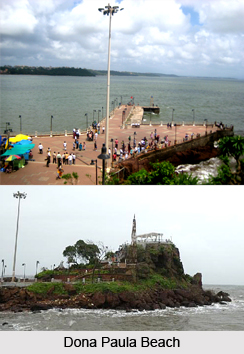 Dona Paula beach, a pristine beach with solitude flavour is located just about seven kilometres from Panaji. This place is known as the Lovers Paradise in North Goa. Dona Paula beach is associated with the colonial love story. If a tourist hears this colonial tale of tragic love, one can easily remind the 16th Century tragic love poem "Love Ullin`s Daughter"
Dona Paula beach, a pristine beach with solitude flavour is located just about seven kilometres from Panaji. This place is known as the Lovers Paradise in North Goa. Dona Paula beach is associated with the colonial love story. If a tourist hears this colonial tale of tragic love, one can easily remind the 16th Century tragic love poem "Love Ullin`s Daughter"
Legend of Dona Paula Beach
According to a legend of Dona Paula beach, the daughter of a Governor General when faced objections from her family about her love affair with a poor fisherman, she jumped off the cliff. The enticing story about the girl was named Dona Paula de Menzes, after whom the Goa beach has been named. Another legend says that the Viceroy`s daughter was pushed off a cliff to drown in the waters below as a punishment for captivating Francisco de Tavora- the Count of Alvor.
Tourism in Dona Paula Beach
Dona Paula beach is a perfect spot to sunbathe and relax. Jet Skiing is a very common sport at this beach. The tranquil and calm atmosphere of the Dona Paula makes it a perfect place for the tourists to relax and laze about. The beach unravels the ultimate in aquatic sport and fun. Dona Paula beach offers some of the best water sports facilities to the sports enthusiasts including Water-scooter rides, Motor-boat rides, etc.
Salim Ali Bird Sanctuary
Dona Paula is also famous for the Salim Ali Bird Sanctuary, where a variety of migratory and local birds can be seen.
Cabo Raj Bhavan
The official residence of the Governor of Goa, known as Cabo Raj Bhavan is situated on the westernmost tip of Dona Paula. Along the road leading to this place is the ruins of the small military cemetery the British built at their brief occupation of the Cabo, to deter the French from invading Goa.
The Dona Paula beach is one of popular and most visited beach of Goa where people flock not only to enjoy the sunbath and the sea but also to indulge in water sports on the clear waters. The Dona Paula Beach offers an opportunity to the tourists to have sunbath and buy inexpensive seaside goods from local vendors. The beach has also been the location for many Indian movies. Given this dual attraction, Dona Paula Beach has become popular among the tourist spots in Goa.
The place where two of Goa`s famous rivers meet the Arabian Sea is the bay of Dona Paula. The bay offers a good view of the scenic beauty of the Marmagao Harbour. A nearby fishing village is located on the south side of the hammer-shaped headland that divides the Zuari and Mandovi. This village has now become turned into a commercialised spot.



















